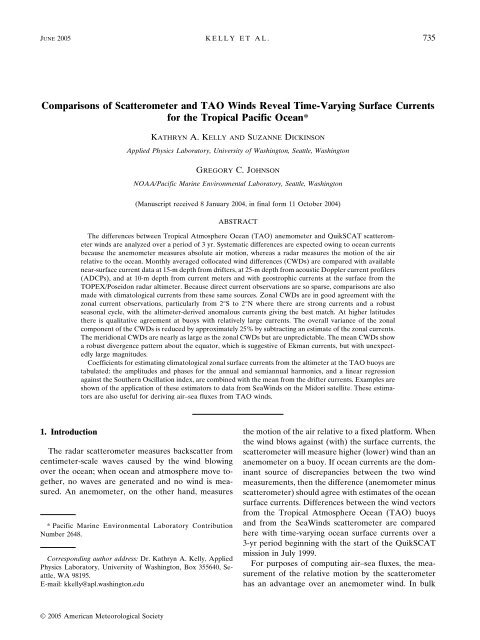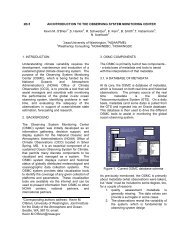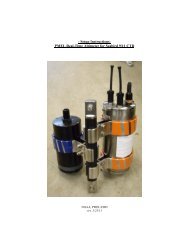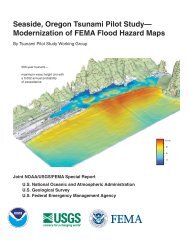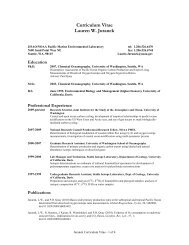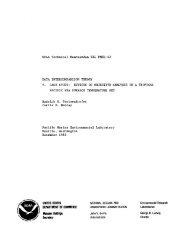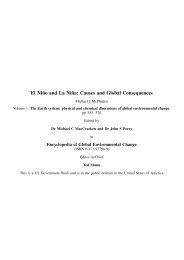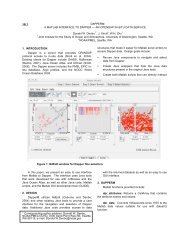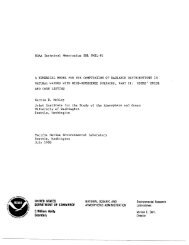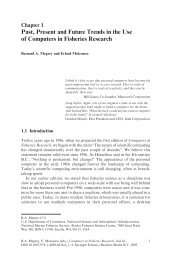PDF (360 KB) - American Meteorological Society
PDF (360 KB) - American Meteorological Society
PDF (360 KB) - American Meteorological Society
You also want an ePaper? Increase the reach of your titles
YUMPU automatically turns print PDFs into web optimized ePapers that Google loves.
JUNE 2005 K E L L Y E T A L . 735<br />
Comparisons of Scatterometer and TAO Winds Reveal Time-Varying Surface Currents<br />
for the Tropical Pacific Ocean*<br />
KATHRYN A. KELLY AND SUZANNE DICKINSON<br />
Applied Physics Laboratory, University of Washington, Seattle, Washington<br />
GREGORY C. JOHNSON<br />
NOAA/Pacific Marine Environmental Laboratory, Seattle, Washington<br />
(Manuscript received 8 January 2004, in final form 11 October 2004)<br />
ABSTRACT<br />
The differences between Tropical Atmosphere Ocean (TAO) anemometer and QuikSCAT scatterometer<br />
winds are analyzed over a period of 3 yr. Systematic differences are expected owing to ocean currents<br />
because the anemometer measures absolute air motion, whereas a radar measures the motion of the air<br />
relative to the ocean. Monthly averaged collocated wind differences (CWDs) are compared with available<br />
near-surface current data at 15-m depth from drifters, at 25-m depth from acoustic Doppler current profilers<br />
(ADCPs), and at 10-m depth from current meters and with geostrophic currents at the surface from the<br />
TOPEX/Poseidon radar altimeter. Because direct current observations are so sparse, comparisons are also<br />
made with climatological currents from these same sources. Zonal CWDs are in good agreement with the<br />
zonal current observations, particularly from 2°S to 2°N where there are strong currents and a robust<br />
seasonal cycle, with the altimeter-derived anomalous currents giving the best match. At higher latitudes<br />
there is qualitative agreement at buoys with relatively large currents. The overall variance of the zonal<br />
component of the CWDs is reduced by approximately 25% by subtracting an estimate of the zonal currents.<br />
The meridional CWDs are nearly as large as the zonal CWDs but are unpredictable. The mean CWDs show<br />
a robust divergence pattern about the equator, which is suggestive of Ekman currents, but with unexpectedly<br />
large magnitudes.<br />
Coefficients for estimating climatological zonal surface currents from the altimeter at the TAO buoys are<br />
tabulated: the amplitudes and phases for the annual and semiannual harmonics, and a linear regression<br />
against the Southern Oscillation index, are combined with the mean from the drifter currents. Examples are<br />
shown of the application of these estimators to data from SeaWinds on the Midori satellite. These estimators<br />
are also useful for deriving air–sea fluxes from TAO winds.<br />
1. Introduction<br />
The radar scatterometer measures backscatter from<br />
centimeter-scale waves caused by the wind blowing<br />
over the ocean; when ocean and atmosphere move together,<br />
no waves are generated and no wind is measured.<br />
An anemometer, on the other hand, measures<br />
* Pacific Marine Environmental Laboratory Contribution<br />
Number 2648.<br />
Corresponding author address: Dr. Kathryn A. Kelly, Applied<br />
Physics Laboratory, University of Washington, Box 355640, Seattle,<br />
WA 98195.<br />
E-mail: kkelly@apl.washington.edu<br />
the motion of the air relative to a fixed platform. When<br />
the wind blows against (with) the surface currents, the<br />
scatterometer will measure higher (lower) wind than an<br />
anemometer on a buoy. If ocean currents are the dominant<br />
source of discrepancies between the two wind<br />
measurements, then the difference (anemometer minus<br />
scatterometer) should agree with estimates of the ocean<br />
surface currents. Differences between the wind vectors<br />
from the Tropical Atmosphere Ocean (TAO) buoys<br />
and from the SeaWinds scatterometer are compared<br />
here with time-varying ocean surface currents over a<br />
3-yr period beginning with the start of the QuikSCAT<br />
mission in July 1999.<br />
For purposes of computing air–sea fluxes, the measurement<br />
of the relative motion by the scatterometer<br />
has an advantage over an anemometer wind. In bulk<br />
© 2005 <strong>American</strong> <strong>Meteorological</strong> <strong>Society</strong>
736 JOURNAL OF ATMOSPHERIC AND OCEANIC TECHNOLOGY VOLUME 22<br />
parameterizations (e.g., Liu et al. 1979), surface stress <br />
and all other air–sea fluxes are a function of the difference<br />
between the wind at a reference height U and the<br />
current at the ocean surface U s ,as<br />
C D |U U s |U U s .<br />
The wind derived from the scatterometer backscatter<br />
represents the relative motion, U – U s . To derive stress<br />
from an anemometer wind or from any other absolute<br />
wind measurement, it is necessary to subtract an estimate<br />
of the ocean surface current. The relative motion,<br />
U – U s , is also needed for other bulk flux formulas. The<br />
ocean currents are frequently neglected in the bulk formula,<br />
because ocean surface currents are not readily<br />
available; however, a combination of weak winds and<br />
strong currents will give large errors in these flux estimates.<br />
Previous comparisons between TAO and scatterometer<br />
winds with currents using relatively small amounts<br />
of data suggested an important role for currents in the<br />
difference. Collocated wind differences (CWDs) from<br />
the National Aeronautics and Space Administration<br />
(NASA) Scatterometer (NSCAT) and TAO anemometers<br />
showed qualitative agreement with currents from<br />
a single current meter on the equator over a 7-month<br />
period, as currents reversed during the onset of the<br />
1997 ENSO warm event (Dickinson et al. 2001). Similarly,<br />
good agreement was found between QuikSCAT<br />
winds and currents from an acoustic Doppler current<br />
profiler (ADCP) mounted on a ship servicing the TAO<br />
array, averaged over a 3-week period (Kelly et al.<br />
2001). In the comparison with QuikSCAT winds, currents<br />
in the South Equatorial Current (SEC) were<br />
about 1.2 m s 1 westward and currents in the North<br />
Equatorial Countercurrent (NECC) were about 0.6<br />
ms 1 eastward over the short period examined. Neglect<br />
of these strong equatorial currents in this region of<br />
relatively weak winds (5–7 m s 1 ) was estimated to<br />
cause errors in stress of 25%–50% and even larger errors<br />
in wind stress curl.<br />
Here, we compare 3 yr of CWDs with surface currents<br />
at most of the TAO buoys (Fig. 1). The CWDs,<br />
which are computed from the difference of two observations,<br />
are likely to be noisier than either; in fact, if the<br />
error variance for the anemometer is 2 a and the error<br />
variance for the scatterometer is 2 s, then the error variance<br />
for the current estimate is 2 a 2 s, assuming these<br />
errors are uncorrelated. Therefore, it was necessary to<br />
edit and temporally average the CWDs for the comparisons.<br />
The goals of this analysis are 1) to demonstrate that<br />
systematic differences between (zonal) TAO anemometer<br />
and QuikSCAT winds are from time-varying ocean<br />
1<br />
FIG. 1. Estimated mean currents. Difference between TAO and<br />
QuikSCAT winds for (a) collocated pairs of vectors from Jul 1999<br />
to Aug 2002 and (b) all daily TAO winds and QuikSCAT winds<br />
from gridded fields for Jul 1999–Aug 2003. (c) Mean currents<br />
from 15-m-deep drifters at the TAO mooring locations.<br />
currents, 2) to find (and provide) appropriate current<br />
estimators to convert between the relative scatterometer<br />
and absolute anemometer winds, and 3) to demonstrate<br />
the need to include ocean currents in anemometer/scatterometer<br />
validation studies.<br />
Although TAO buoys are not used in the calibration<br />
of the scatterometer model function (see, e.g., Wentz<br />
and Smith 1999), which relates direction and speed to<br />
radar backscatter, they are used to “validate” the<br />
winds. The model function is based on global collocated<br />
backscatter with several months of wind vectors from<br />
numerical weather prediction models; the calibration is<br />
a highly overdetermined problem with most of the<br />
winds from regions of weak ocean currents. To illustrate<br />
the independence of the buoy and scatterometer<br />
winds, we note that the European Remote Sensing Satellite-1<br />
(ERS-1), NSCAT, and QuikSCAT scatterometers<br />
all showed systematic direction biases to the right<br />
of the TAO anemometers of approximately 9°–11°, a<br />
remarkable consistency. Subsequent analyses of the accuracy<br />
of the ATLAS anemometers revealed a 6.8° bias<br />
to the left (Freitag et al. 2001), accounting for much of<br />
what was observed by the scatterometers. (This direction<br />
error has been corrected in the TAO winds.)<br />
Anemometer winds are used to check the scatterometer<br />
speed and direction accuracy (“validation”), and,<br />
therefore, it is critical that we understand the nature of<br />
the differences in the measurements. In the validation<br />
of the NSCAT model function, initial TAO buoy/<br />
NSCAT comparisons suggested that the scatterometer<br />
winds were too low by about 0.5 m s 1 . However, after<br />
equatorial currents reversed early in 1997, scatterom-
JUNE 2005 K E L L Y E T A L . 737<br />
eter winds appeared to be too high, as would be expected<br />
for a relative motion measurement, demonstrating<br />
the need to include ocean currents in the comparisons.<br />
In the QuikSCAT validation, after removing the<br />
measured currents in the CWDs, the model function<br />
bias was found to be a negligible 0.1 m s 1 (Kelly et al.<br />
2001).<br />
The need for a conversion between buoy and scatterometer<br />
winds also arises in the evaluation of flux<br />
products. In bulk formulas for estimating latent and<br />
sensible heat fluxes, for example, the relative motion U<br />
– U s is also needed. At 140°W on the equator, where<br />
current measurements are available, latent heat flux<br />
estimated with and without these energetic ocean currents<br />
had a seasonally varying difference with amplitude<br />
of about 7 W m 2 and a mean of 2 W m 2 (M.<br />
Cronin 2004, personal communication). To determine,<br />
for example, whether the use of scatterometer winds<br />
improves air–sea flux products, as in recent studies by<br />
Yu et al. (2004), an accurate comparison with fluxes<br />
from a bulk formula at a TAO buoy would also require<br />
a current estimate (few TAO buoys have current<br />
meters).<br />
2. Collocated wind vectors<br />
The TAO buoys used in this study are located in the<br />
equatorial Pacific Ocean bounded by 8°S, 12°N, 165°E,<br />
and 95°W. High-resolution TAO buoy data were collected<br />
from the beginning of the QuikSCAT mission,<br />
July 1999 through August 2002. The buoy data include<br />
zonal and meridional wind components, air temperature,<br />
sea surface temperature, and relative humidity.<br />
The sampling rate for all variables except the sea surface<br />
temperature is 2 Hz, with a sampling period of 2<br />
min. Data are recorded every 10 min. The sea surface<br />
temperature data are instantaneous measurements<br />
taken once every 10 min. The winds, which are measured<br />
at a height of 4 m above the ocean surface, are<br />
converted to a 10-m height in a neutrally stratified atmosphere<br />
using the standard L<strong>KB</strong> algorithm (Liu et al.<br />
1979). The 6.8° wind direction bias (Freitag et al. 2001)<br />
has been removed from the TAO data. TAO winds are<br />
temporally averaged to give hourly winds.<br />
QuikSCAT scatterometer wind speed and direction<br />
data [standard L2B product from Physical Oceanography<br />
Distributed Active Archive Center (PO.DAAC)]<br />
(Wentz and Smith 1999; Huddleston et al. 1996) were<br />
collected over the 3-yr time period. The scatterometer<br />
data are calibrated to approximate a wind at 10 m<br />
above the ocean surface in a neutrally stratified atmosphere<br />
and have a spatial resolution of 25 km. Data<br />
pairs were considered collocated when the scatterometer<br />
cell center was within 25 km of a buoy and the time<br />
difference was less than 30 min, giving a unique pairing<br />
with the hourly TAO winds.<br />
The collocated pairs were screened for rain, wind<br />
direction, and wind speed. The rain screen was performed<br />
using collocated rain estimates derived from the<br />
Special Sensor Microwave Imager (SSM/I) (courtesy of<br />
Remote Sensing Systems). The rain estimates consist of<br />
a rain rate (or designation of “no rain”) and the time<br />
difference between the SSM/I and the scatterometer<br />
measurement (maximum of 3 h). Because we only used<br />
CWDs for which there was a rain estimate indicating<br />
“no rain detected within 50 km” of the scatterometer<br />
vector, there was a trade-off between reducing rain<br />
contamination (and therefore the variance of the<br />
CWDs) by selecting a short time difference and the<br />
amount of data available for our analysis. We examined<br />
the variance of the CWDs for maximum time differences<br />
of 30, 60, 120, and 180 min; the CWD variance for<br />
the less-stringent 180-min time window was only a few<br />
percent higher than the variance for the 30-min time<br />
window, but the number of CWDs was double that for<br />
the 30-min window. The negligible increase in variance<br />
suggests that using the less restrictive 3-h time window<br />
does not degrade the scatterometer wind quality.<br />
Therefore, to maximize the amount of data for analysis,<br />
a collocated buoy–scatterometer pair was included if<br />
there was an SSM/I estimate within 3hofthescatterometer<br />
measurement that indicated no rain was<br />
present.<br />
The scatterometer model function gives up to four<br />
possible wind vectors, owing to the similarity of the<br />
backscatter from different viewing geometries. To ensure<br />
that the correct scatterometer vector was selected,<br />
the collocated pair was retained only if the difference in<br />
the wind directions between buoy and scatterometer<br />
was less than 60°. Last, if the buoy wind speed was 3<br />
ms 1 or less the pair was excluded owing to the difficulty<br />
of both sensors in measuring directions for low<br />
wind speeds. Of the initial collocations, 10% had buoy<br />
wind speeds below the threshold, 6% had directional<br />
differences that were too large, and 18% had no SSM/I<br />
flag within3hortheSSM/I flag indicated rain. Overall,<br />
74% of the pairs met the above requirements, resulting<br />
in a dataset of 28 031 collocated wind pairs.<br />
Tropical Pacific Ocean CWDs were estimated by<br />
subtracting QuikSCAT scatterometer wind vectors<br />
from collocated TAO vectors at 56 TAO buoys. Even<br />
after the screening described above, the screened<br />
CWDs were quite noisy. To reduce the noise, CWDs<br />
with speeds of 2 m s 1 or greater were removed, as<br />
these represent unrealistically large values for ocean<br />
currents and were suspected to be contaminated by a
738 JOURNAL OF ATMOSPHERIC AND OCEANIC TECHNOLOGY VOLUME 22<br />
noise source, such as undetected rain. In addition, a<br />
2-month running mean at monthly intervals was computed<br />
for the zonal and meridional components and<br />
three-standard-deviation outliers from these means<br />
were removed. These criteria eliminated 15% of the<br />
remaining data. The 2-month running mean was computed<br />
on the remaining CWDs, and these monthly<br />
means were used for comparisons with ocean currents.<br />
3. Current observations<br />
There are several sources of near-surface velocity<br />
measurements available for comparisons: moored and<br />
shipboard ADCPs, drifters, one current meter, and altimetric<br />
sea surface height. Moored ADCP data were<br />
available at four equatorial buoys in our domain. A<br />
single current meter at 110°W on the equator measured<br />
10-m currents for a few months in 2001, allowing another<br />
comparison.<br />
Because so few direct current measurements were<br />
available at the TAO buoys during our study period, we<br />
used current estimates from the other data sources.<br />
Currents at 15 m from the drogued drifters of the Global<br />
Drifter Program were daily averaged and fit to a<br />
function in time and space (Johnson 2001). The mean,<br />
annual, and semiannual harmonics, and an SOI regression<br />
coefficient for both zonal and meridional currents<br />
were estimated at the TAO buoy locations from over<br />
two decades of data. From the zonal coefficients we<br />
constructed a climatological drifter current time series.<br />
We also examined current estimates from shipboard<br />
ADCP data from the shallowest depth at 25 m. Climatological<br />
zonal velocities were constructed from 172<br />
longitudinal transects of shipboard ADCP data from<br />
1985 though 2001 based on a regression analysis<br />
(Johnson et al. 2002). Meridional ADCP currents are<br />
badly aliased by sparse sampling in the presence of<br />
strong tropical instability waves (TIWs), and the resulting<br />
climatological meridional estimates may be weak.<br />
Sea surface height (SSH) data measured by the<br />
TOPEX/Poseidon altimeter were used to compute<br />
anomalous geostrophic ocean surface currents, with the<br />
following set of equations:<br />
u g g <br />
f y<br />
g g , 2<br />
<br />
f x<br />
where is the SSH anomaly and f is the Coriolis parameter.<br />
At the equator, where f is zero, a revised formulation<br />
was used for the zonal currents, as<br />
u g g 2 <br />
y 2 ,<br />
where f/y (Jerlov 1953).<br />
We used SSH data with a resolution of 6° 6° 0<br />
days, mapped to a 1° 1° 10 day grid, centered on<br />
the half degree. The coarse spatial resolution is set by<br />
the 3° altimeter track spacing. The computation of geostrophic<br />
velocity using (2) becomes quite sensitive to<br />
noise in the SSH near the equator (as f approaches<br />
zero). In addition, geostrophic velocities may exceed<br />
the actual velocities (Lagerloef et al. 1999; Bonjean and<br />
Lagerloef 2002), because the dynamical balances, even<br />
as far as 2° from the equator, are not simple.<br />
Therefore, to obtain velocity estimates we used the<br />
following procedure. Geostrophic velocities were computed<br />
using (2) and centered differences on the halfdegree<br />
grid down to a latitude of 2.5°. SSH was then<br />
regridded to a 0.5° grid near the equator to allow a<br />
computation of the velocity on the equator using (3)<br />
and a centered difference. Then, at each 10-day interval<br />
and at each longitude, the geostrophic velocities from<br />
4.5°Sto4.5°N, combined with the estimate on the equator,<br />
were interpolated to the half-degree grid using<br />
overdetermined biharmonic splines, which give a<br />
smooth estimate without the problematic overshoot of<br />
an unconstrained spline (Sandwell 1987). This procedure<br />
resulted in slightly smaller geostrophic velocities<br />
at 2°S and 2°N than the direct geostrophic calculation<br />
using (2).<br />
To compare with the winds at each TAO buoy, the<br />
four velocity time series surrounding each buoy location<br />
were averaged. Monthly velocity estimates were<br />
smoothed using a 2-month running mean. We used the<br />
entire record of the altimeter data (10 yr) to compute<br />
the climatological current estimates as described below.<br />
An equivalent relationship to (3) can be derived for<br />
the meridional component, which includes higher derivatives<br />
of the SSH data and is therefore noisy. However,<br />
it was not used because, as discussed below, meridional<br />
currents do not appear to be geostrophic.<br />
4. Comparisons of the means<br />
The 3-yr mean CWDs (Fig. 1a) have a similar pattern<br />
to that found by Quilfen et al. (2001). To determine to<br />
what extent this CWD pattern was affected by using a<br />
relatively small subset of the wind data (collocated<br />
pairs), we compared the difference of the TAO daily<br />
winds and the QuikSCAT daily winds derived from<br />
gridded maps (Fig. 1b) (Kelly et al. 1999). In both<br />
cases, the annual and semiannual harmonics were first<br />
removed before computing the mean to prevent the<br />
3
JUNE 2005 K E L L Y E T A L . 739<br />
seasonal cycle for partial years from biasing the estimate.<br />
The mean wind difference maps are quite similar<br />
overall, suggesting that the set of CWDs is sufficiently<br />
large to give a robust estimate of the difference field.<br />
The CWDs are compared with the means from the<br />
climatological drifter estimates in Fig. 1c. The zonal<br />
CWD and drifter mean currents are similar: predominantly<br />
westward along the equator (South Equatorial<br />
Current) and predominantly eastward at 5° and 8°N<br />
(North Equatorial Countercurrent), with magnitudes of<br />
about 0.5 m s 1 . However, there are much larger meridional<br />
components in the CWDs than in the drifter<br />
means. Both are, in the sense of an Ekman divergence,<br />
driven by easterly trade winds. The mean CWDs are far<br />
more divergent about the equator than the mean drifter<br />
currents. Given the differences in the mean components,<br />
we discuss the comparisons of each component<br />
separately below.<br />
5. Zonal comparisons<br />
We present the time series of zonal CWDs and the<br />
zonal velocity observations described above at each<br />
buoy location, with plots laid out geographically (upper<br />
panels of Fig. 2). Plots from a buoy are shown if the<br />
CWDs are available for at least two-thirds of the 3-yr<br />
record. Missing buoy winds generally limit the number<br />
of collocations. At most buoys only the geostrophic current<br />
anomalies are available. Geostrophic velocity estimates<br />
have zero mean and are therefore offset from the<br />
CWDs because they are derived from SSH anomalies<br />
relative to a 10-yr record mean. The CWD and geostrophic<br />
velocity amplitudes are quite similar for 2°S–<br />
2°N. The CWDs show good agreement, particularly in<br />
the seasonal cycle, with all the observed zonal velocities.<br />
At 170°, 140°, and 110°W on the equator, where<br />
some moored ADCP data are also available, all of the<br />
velocity estimates are quite similar in phase and in magnitude.<br />
There is also good agreement with the 10-m<br />
currents at 110°W on the equator. The comparison at<br />
140°W is enlarged (Fig. 3) to highlight the long ADCP<br />
record.<br />
To allow comparisons with the sparse drifter and<br />
shipboard ADCP data, climatological current estimates<br />
were computed (lower panels of Figs. 2 and 3). The<br />
drifter estimator (Johnson 2001) consists of a mean, an<br />
annual and a semiannual harmonic, and a factor correlated<br />
with the Southern Oscillation index (SOI). The<br />
ADCP estimator has only a mean and an annual harmonic.<br />
The advantage of using estimators is that a current<br />
estimate can readily be derived for any TAO buoy<br />
at any time, if there are no concurrent velocity observations.<br />
A similar estimator is derived from the geostrophic<br />
currents by regressions, using<br />
U s t a 1 cos2tT 1 a 2 cos4tT 2 <br />
b SOI c,<br />
4<br />
where the coefficients a 1 , 1 , a 2 , and 2 are the amplitude<br />
and phase for the annual and semiannual harmonics,<br />
b is derived from a linear regression against the<br />
SOI, and c is the mean. The time t is in days (t 0<br />
corresponds to the start of any given year), T 365.25,<br />
and the SOI is interpolated to the times t. We use SSH<br />
data for nearly 10 yr (November 1992 through the<br />
middle of 2002) to derive the coefficients. Because the<br />
geostrophic currents lack a mean, the drifter mean is<br />
used in the altimeter estimator.<br />
The CWDs and the velocity data tend to be larger<br />
than the climatological estimators, which are derived<br />
from regressions. Of the three estimators, the one derived<br />
from the altimeter (a surface velocity estimate<br />
with a long and complete record) generally has the largest<br />
amplitudes, followed by the drifter, with the ADCP<br />
estimates having the smallest amplitudes. The reduction<br />
in amplitudes for the ADCP and drifter estimators<br />
is due in part to the need to fit the sparse data to a<br />
spatial function.<br />
Statistics of the comparisons between CWDs and<br />
currents are included in Table 1, which gives the fraction<br />
of the variance (“skill”) in zonal CWDs described<br />
by three different current estimators. Skill is defined<br />
here as<br />
skill 1 2 <br />
,<br />
5<br />
2<br />
where the error is the estimated current minus the<br />
CWD, 2 is the variance of the CWD, and · is the<br />
ensemble average. In this context, the skill represents<br />
the reduction in CWD variance that results from subtracting<br />
a given ocean current estimator. The skill, or<br />
variance reduction, is given instead of a correlation because<br />
it is a more stringent test, penalizing errors in<br />
both the mean of the estimator and its amplitude; an<br />
estimator that is much too small, for example, can have<br />
a high correlation, but it will have a low skill (a small<br />
reduction in CWD variance).<br />
Skill is 23% for the drifters overall and 17% for the<br />
altimeter (with the drifter mean). The ADCP estimator<br />
has no significant skill. Although the skill of the drifter<br />
estimator is larger than that for the altimeter, the amplitudes<br />
of the altimeter estimates are much closer to<br />
the amplitudes of the CWDs. The skill is quite sensitive<br />
to the mean difference between the CWDs and the<br />
estimator. The drifter means are more westward than<br />
the means of the CWDs by an average of 0.09 m s 1 .
740 JOURNAL OF ATMOSPHERIC AND OCEANIC TECHNOLOGY VOLUME 22<br />
FIG. 2. Zonal wind differences and velocities at TAO buoys. Panels are laid out geographically to represent TAO buoy locations.<br />
(top) Monthly CWDs (red dots), geostrophic current anomalies (green), ADCP (blue), and current meter (magenta) on the equator<br />
at 110° and 140°W. Geostrophic currents have zero mean. (bottom) Monthly CWDs (repeated), current estimators from ADCP (blue<br />
dashed), drifters (cyan dashed), and geostrophic with drifter mean (black). Units: m s 1 .
JUNE 2005 K E L L Y E T A L . 741<br />
FIG. 2.(Continued)
742 JOURNAL OF ATMOSPHERIC AND OCEANIC TECHNOLOGY VOLUME 22<br />
To obtain relative zonal motion, U U s , the estimate<br />
of U s must be subtracted from the absolute (zonal)<br />
wind U (e.g., anemometer wind). The meridional component<br />
would be unchanged because, as discussed below,<br />
no meridional current estimator has significant<br />
skill.<br />
FIG. 3. As in Fig. 2, for just the TAO buoy at 140°W on the<br />
equator.<br />
Adding 0.1 m s 1 everywhere to the altimeter estimates<br />
increases the skill to 30% (Table 1). Despite the strong<br />
qualitative resemblance between CWDs and altimeter<br />
estimators from 2°S to2°N, skill (28%) is not higher<br />
there than for the overall average because two buoys<br />
(2°N, 180° and 2°N, 125°W) have large biases between<br />
the CWDs and the drifter mean.<br />
The biases between the CWDs and the current estimators<br />
may result from an error in the scatterometer or<br />
TAO wind speed, interannual variations in currents<br />
(not parameterized by the SOI), or vertical shear in the<br />
water column. Because winds in the TAO array are<br />
predominantly westward, the bias would correspond to<br />
QuikSCAT wind speeds, being on average 0.1 m s 1<br />
higher than the TAO winds, after accounting for currents,<br />
a relatively small error and well within the expected<br />
measurement errors of either. Alternatively, if<br />
the bias is from vertical shear, then the zonal surface<br />
currents are more eastward (generally, weaker) than<br />
the currents at 15 m.<br />
The coefficients used for the altimeter estimator are<br />
given in Table 2 for each TAO buoy. The coefficients<br />
include the drifter mean plus 0.1 m s 1 . An estimator<br />
for the zonal surface currents, U s , needed to correct<br />
zonal anemometer winds U in air–sea flux bulk formulas<br />
or for scatterometer–buoy comparisons, can be constructed<br />
for any time using (4) and these coefficients.<br />
TABLE 1. Skill of estimators.<br />
Data for estimator<br />
Skill<br />
Drifters 0.23<br />
Altimeter drifter mean 0.17<br />
Altimeter drifter mean 0.1 m s 1 0.30<br />
Altimeter (2°S–2°N) 0.28<br />
6. Meridional velocities<br />
Meridional CWDs are less predictable than their<br />
zonal counterparts but equally energetic. The overall<br />
rms values for the zonal and meridional CWDs are 0.41<br />
and 0.43 m s 1 , respectively. The meridional analysis is<br />
difficult because the TIWs are probably overwhelming<br />
the mean, seasonal, or interannual components of the<br />
velocity. Geostrophic currents tend to be predominantly<br />
zonal, as are winds in the equatorial Pacific; thus,<br />
the Ekman component of the currents would be expected<br />
to be relatively large in this region. However,<br />
Ekman drift transitions to downwind drift approaching<br />
the equator, and this dynamical shift starts poleward of<br />
2°N and 2°S. The meridional geostrophic current<br />
anomalies, in fact, are small and have no skill in estimating<br />
the meridional CWDs. The skill of the drifter<br />
estimates (which include an Ekman current component)<br />
is also quite small.<br />
The means of the meridional CWDs for each buoy,<br />
plotted against the meridional drifter means (Fig. 4),<br />
show considerable scatter. Bin averaging the means by<br />
latitude reveals that meridional CWD means generally<br />
exceed drifter means by about a factor of 2 and that<br />
both estimates of mean currents are poleward, creating<br />
a mean divergence about the equator, as seen in Fig. 1.<br />
Ekman dynamics suggest that the surface velocities<br />
(corresponding to the CWDs) should be larger than<br />
those at 15 m (the drifter velocity depth); however, the<br />
magnitudes of the CWD vectors are larger than might<br />
be expected from an oceanic Ekman response (Ralph<br />
and Niiler 1999). We were unable to find systematic<br />
correlations between the time series of CWDs and wind<br />
stress that would indicate that they are in fact an Ekman<br />
response.<br />
7. Application to scatterometer validation<br />
In situ wind observations are routinely used to validate<br />
the empirical model function used to convert radar<br />
backscatter to wind vectors. Buoy winds have been<br />
used extensively in these efforts, and the TAO array<br />
contributes a large fraction of available buoy winds.<br />
Without a current correction, TAO buoy wind comparisons<br />
suggest that the QuikSCAT winds are too<br />
weak in the 3–10 m s 1 range, by the amount of the<br />
mean differences shown in Fig. 1a. This apparent bias
JUNE 2005 K E L L Y E T A L . 743<br />
TABLE 2. Coefficients for zonal surface currents. Angles 1 and 2 are in radians. (Table is available online at<br />
http://ultrasat.apl.washington.edu/kkelly/ovwst.)<br />
Lat Lon c a 1 1 a 2 2 b Lat Lon c a 1 1 a 2 2 b<br />
0° 137°E 0 0 0 0 0 0.46 8°S 155°W 0.01 0.06 1.59 0 0 0.05<br />
2°N 137°E 0.09 0.34 1.42 0.17 0.41 0.33 5°S 155°W 0.14 0 0 0 0 0.11<br />
5°N 137°E 0.48 0.18 1.14 0 0 0.02 2°S 155°W 0.15 0.20 2.44 0.20 1.44 0.15<br />
8°N 137°E 0.03 0.09 1.07 0.07 2.82 0.06 0° 155°W 0.04 0.23 2.78 0.29 1.40 0.25<br />
0° 147°E 0.10 0.15 1.99 0.13 0.29 0.12 2°N 155°W 0.24 0.45 2.09 0.34 1.21 0.26<br />
2°N 147°E 0.12 0.19 2.10 0.14 0.15 0.17 5°N 155°W 0.18 0 0 0 0 0.19<br />
5°N 147°E 0.35 0.19 0.16 0 0 0.07 8°N 155°W 0.31 0.34 0.11 1.01 2.37 0.01<br />
5°S 156°E 0.01 0.09 1.12 0 0 0.10 8°S 140°W 0.05 0 0 0.05 0.51 0.07<br />
2°S 156°E 0.08 0.27 1.92 0.20 0.14 0.20 5°S 140°W 0.16 0 0 0.08 1.89 0.12<br />
0° 156°E 0.13 0.23 2.40 0.24 0.20 0.17 2°S 140°W 0.02 0.18 2.74 0.21 1.75 0.10<br />
2°N 156°E 0.05 0.23 2.52 0.21 0.25 0.22 0° 140°W 0.01 0.26 2.33 0.34 1.81 0.24<br />
5°N 156°E 0.30 0.18 0.52 0 0 0.07 2°N 140°W 0.30 0.50 1.83 0.37 1.80 0.26<br />
8°N 156°E 0.09 0.19 0.19 0.08 2.54 0.01 5°N 140°W 0.12 0 0 0.16 0.15 0.16<br />
9°N 140°W 0.19 0.27 1.04 0.06 3.14 0.03<br />
8°S 165°E 0.11 0.17 0.72 0 0 0 8°S 125°W 0.05 0.04 0.15 0 0 0.07<br />
5°S 165°E 0.02 0.14 1.54 0 0 0.15 5°S 125°W 0.21 0.09 0.09 0 0 0.11<br />
2°S 165°E 0.09 0.32 2.21 0.25 0.24 0.19 2°S 125°W 0.03 0.17 3.10 0.19 1.73 0.11<br />
0° 165°E 0.08 0.27 2.82 0.28 0.40 0.21 0° 125°W 0.02 0.30 1.99 0.28 2.12 0.26<br />
2°N 165°E 0.05 0.30 3.06 0.22 0.25 0.29 2°N 125°W 0.50 0.54 1.55 0.30 2.45 0.27<br />
5°N 165°E 0.26 0.16 1.07 0 0 0.10 5°N 125°W 0.08 0 0 0 0 0.16<br />
8°N 165°E 0.09 0.21 0.11 0.05 2.90 0.04 8°N 125°W 0.38 0.36 0.11 0.11 0.24 0.02<br />
8°S 180° 0.06 0.12 0.17 0 0 0.06 8°S 110°W 0.08 0.08 0.06 0.05 1.07 0.06<br />
5°S 180° 0.05 0.11 1.92 0 0 0.12 5°S 110°W 0.22 0.08 0.48 0 0 0.10<br />
2°S 180° 0.10 0.31 2.31 0.20 0.77 0.18 2°S 110°W 0.07 0.17 2.47 0.21 1.72 0.15<br />
0° 180° 0.13 0.29 3.02 0.23 0.78 0.26 0° 110°W 0.06 0.40 1.71 0.25 2.19 0.28<br />
2°N 180° 0.19 0.38 2.73 0.25 0.38 0.31 2°N 110°W 0.44 0.54 1.29 0.18 2.46 0.24<br />
5°N 180° 0.25 0.15 0.94 0.10 0.26 0.14 5°N 110°W 0.23 0.19 0.18 0.21 0.12 0.12<br />
8°N 180° 0.18 0.27 0.55 0.09 2.82 0.04 8°N 110°W 0.12 0.31 1.57 0 0 0.04<br />
8°S 170°W 0.04 0.10 0.77 0 0 0.07 8°S 95°W 0.02 0.05 0.34 0.05 0.15 0.03<br />
5°S 170°W 0.11 0.10 2.17 0.08 1.09 0.11 5°S 95°W 0.11 0.06 0.84 0.06 2.33 0.08<br />
2°S 170°W 0.15 0.24 2.39 0.20 0.90 0.14 2°S 95°W 0.01 0 0 0.16 2.07 0.16<br />
0° 170°W 0.11 0.21 3.06 0.27 0.90 0.24 0° 95°W 0.09 0.29 1.22 0 0 0.23<br />
2°N 170°W 0.25 0.37 2.34 0.29 0.71 0.27 2°N 95°W 0.27 0.43 0.98 0 0 0.14<br />
5°N 170°W 0.22 0 0 0 0 0.15 3.5°N 95°W 0.07 0.29 0.87 0 0 0.09<br />
8°N 170°W 0.27 0.33 0.76 0.08 3.13 0 5°N 95°W 0.39 0 0 0.11 0.56 0.07<br />
8°N 95°W 0.17 0.28 1.94 0.10 1.01 0.01<br />
10°N 95°W 0.05 0.07 1.19 0 0 0.02<br />
12°N 95°W 0.03 0.16 1.08 0.05 2.87 0<br />
could be even larger if a period of only a few months is<br />
used for the comparison; ocean currents can be as large<br />
as1ms 1 at many of the TAO buoy locations over a<br />
period of several months.<br />
To illustrate the importance of removing the currents,<br />
we compared daily TAO winds with wind vectors<br />
from the SeaWinds scatterometer on the Japanese Midori<br />
(ADEOS-II) satellite. Calibration and preliminary<br />
validation of the SeaWinds instrument was based on<br />
only a few months of data (F. Wentz and D. Smith 2003,<br />
personal communication) (Fig. 5). These efforts require<br />
a timely comparison, which may preclude the availability<br />
of simultaneous current measurements. Therefore,<br />
the climatological estimators are particularly relevant<br />
for this application.<br />
For three TAO buoys along 155°W (Fig. 5), Sea-<br />
Winds data within 25 km were screened for rain and<br />
data from the problematic outer swath edges were<br />
eliminated. Nearby screened data from a single swath<br />
(up to four vectors) were averaged, and then the time<br />
series of vectors were filtered using the 5-day running<br />
mean. The TAO anemometer winds were also filtered<br />
using a 5-day running mean. Zonal scatterometer winds<br />
were subtracted from zonal TAO winds, and the CWDs<br />
were filtered using a 2-month running mean. At each<br />
buoy we used the coefficients in Table 2 and Eq. (4) to<br />
compute an estimate of the zonal current. The SOI<br />
(available from ftp://ftp.bom.gov.au/anon/home/ncc/<br />
www/sco/soi/soiplaintext.html, divided by 10) is customarily<br />
boxcar averaged over 5 months; for this ex-
744 JOURNAL OF ATMOSPHERIC AND OCEANIC TECHNOLOGY VOLUME 22<br />
FIG. 4. Meridional wind differences vs drifters. Temporal average<br />
at each buoy (dots). Means binned by latitude at 8° (triangles),<br />
5° (squares), 2° (stars), and at the equator (circle). Meridional<br />
velocities are generally poleward, with wind differences<br />
exceeding drifter means by a factor of 2.<br />
ample, we averaged the SOI over the 5-month period<br />
spanning the observations. For each buoy the smoothed<br />
CWDs are shown (solid) along with the climatological<br />
current estimate (dashed). In all cases the mean westward<br />
current and its seasonal variations reproduce<br />
qualitatively the smoothed CWDs.<br />
8. Conclusions<br />
We compared 3-yr mean and monthly zonal surface<br />
currents in the tropical Pacific Ocean with collocated<br />
FIG. 5. Example of estimator for SeaWinds on the Midori satellite.<br />
Zonal component of daily TAO buoy wind minus scatterometer<br />
wind (solid) from SeaWinds on Midori and altimeter estimator<br />
(dashed) along 155°W at (a) 2°N, (b) the equator, and<br />
(c) 2°S.<br />
differences between absolute winds measured from anemometers<br />
on TAO buoys and relative winds measured<br />
by the satellite-based QuikSCAT scatterometer. Mean<br />
zonal CWDs resemble the mean currents from 15-m<br />
deep drifters; however, mean meridional CWDs are<br />
much larger than mean meridional drifter currents. The<br />
divergence of the mean CWDs (Fig. 1) about the equator<br />
is suggestive of an Ekman response.<br />
Between 2°S and 2°N, where currents are relatively<br />
large, collocated wind differences (CWDs) agree qualitatively<br />
with near-surface currents from ADCP, current<br />
meters, and monthly surface geostrophic current<br />
anomalies from the TOPEX/Poseidon altimeter. At<br />
higher latitudes, the agreement is less clear.<br />
The CWDs are also compared with climatological<br />
current estimators from drifters at 15-m depth, shipboard<br />
ADCP, and the geostrophic currents. Climatological<br />
estimators are used for drifter and ADCP data,<br />
owing to relatively sparse spatial and temporal sampling.<br />
The estimators consist (where available) of a<br />
mean, an annual, and a semiannual harmonic, and a<br />
factor related to the Southern Oscillation index (SOI).<br />
The drifter and ADCP magnitudes are considerably<br />
smaller than those of the altimeter and the CWDs, apparently<br />
the result of spatial smoothing. There is a significant<br />
reduction in CWD variance (skill) by subtracting<br />
either the altimeter or drifter estimators. However,<br />
the ADCP estimator does not significantly reduce the<br />
variance. There is a mean bias between the drifters and<br />
the CWDs, with drifters approximately 0.1 m s 1 more<br />
westward. It cannot be determined from these data<br />
whether this bias is from the winds or from the currents.<br />
Meridional wind data and estimators show poor<br />
agreement with the meridional CWDs, consistent with<br />
previous unsuccessful attempts by Johnson et al. (2002)<br />
to characterize the meridional currents. Large, but unpredictable,<br />
currents have been attributed primarily to<br />
tropical instability waves. The meridional CWDs here<br />
have magnitudes nearly as large as the zonal component.<br />
We provide (Table 2) the coefficients necessary to<br />
construct time-varying zonal current estimates at most<br />
TAO buoy locations: amplitudes and phases of the annual<br />
and semiannual harmonics, as well as the SOI regression<br />
coefficient from the altimeter data and the<br />
mean from the drifter data. When subtracted from an<br />
absolute (zonal) wind measurement, these time-varying<br />
surface current estimators give an estimate of relative<br />
motion, comparable to a scatterometer wind. The relative<br />
motion can be used to correctly implement bulk<br />
formulas (e.g., Liu et al. 1979) for computing air–sea<br />
fluxes, as well as to improve comparisons between scatterometer<br />
and buoy winds. This procedure could be
JUNE 2005 K E L L Y E T A L . 745<br />
extended to buoys in other regions in a straightforward<br />
fashion, provided altimetric SSH and an estimate of the<br />
mean current are available.<br />
Acknowledgments. We thank the QuikSCAT project<br />
and PO.DAAC for scatterometer winds, the TAO Project<br />
Office for buoy winds and other meteorological<br />
variables, Dudley Chelton and Michael Schlax at OSU<br />
for the altimeter data, and Remote Sensing Systems for<br />
SSM/I data collocated with QuikSCAT. Comments by<br />
anonymous reviewers helped improve the analysis and<br />
clarify the text. KAK and SD were supported by<br />
NASA’s Ocean Vector Winds Science Team (Contract<br />
1216233 with the Jet Propulsion Laboratory). GCJ was<br />
supported by the NOAA Office of Oceanic and Atmospheric<br />
Research and the NOAA Office of Global Programs.<br />
REFERENCES<br />
Bonjean, F., and G. S. E. Lagerloef, 2002: Diagnostic model and<br />
analysis of the surface currents in the tropical Pacific Ocean.<br />
J. Phys. Oceanogr., 32, 2938–2954.<br />
Dickinson, S., K. A. Kelly, M. J. Caruso, and M. J. McPhaden,<br />
2001: Comparisons between the TAO buoy and NASA scatterometer<br />
wind vectors. J. Atmos. Oceanic Technol., 18, 799–<br />
806.<br />
Freitag, H. P., M. O’Haleck, G. C. Thomas, and M. J. McPhaden,<br />
2001: Calibration procedures and instrumental accuracies for<br />
ATLAS wind measurements. NOAA Tech. Memo. OAR<br />
PMEL-119, NOAA/Pacific Marine Environmental Laboratory,<br />
Seattle, WA, 20 pp.<br />
Huddleston, J. N., R. D. West, S. H. Yueh, and Y. T. Wu, 1996:<br />
Advanced techniques for improving wind direction ambiguity<br />
removal in scatterometry. IGARSS ’96: Remote Sensing for a<br />
Sustainable Future, New York, NY, IEEE, 1718–1720.<br />
Jerlov, N. G., 1953: Studies of the equatorial currents in the Pacific.<br />
Tellus, 5, 308–314.<br />
Johnson, G. C., 2001: The Pacific Ocean subtropical cell surface<br />
limb. Geophys. Res. Lett., 28, 1771–1774.<br />
——, B. M. Sloyan, W. S. Kessler, and K. E. McTaggart, 2002:<br />
Direct measurements of upper ocean currents and water<br />
properties across the tropical Pacific Ocean during the 1990’s.<br />
Progress in Oceanography, Vol. 52, Pergamon, 31–61.<br />
Kelly, K. A., S. Dickinson, and Z.-J. Yu, 1999: NSCAT tropical<br />
wind stress maps: Implications for improving ocean modeling.<br />
J. Geophys. Res., 104C, 11 291–11 310.<br />
——, ——, M. J. McPhaden, and G. C. Johnson, 2001: Ocean<br />
currents evident in satellite wind data. Geophys. Res. Lett.,<br />
28, 2469–2472.<br />
Lagerloef, G. S. E., G. T. Mitchum, R. B. Lukas, and P. P. Niiler,<br />
1999: Tropical Pacific near-surface currents estimated from<br />
altimeter, wind and drifter data. J. Geophys. Res., 104,<br />
23 313–23 326.<br />
Liu, W. T., K. B. Katsaros, and J. A. Businger, 1979: Bulk parameterization<br />
of air–sea exchanges of heat and water vapor including<br />
the molecular constraints at the interface. J. Atmos.<br />
Sci., 36, 1722–1735.<br />
Quilfen, Y., B. Chapron, and D. Vandemark, 2001: The ERS<br />
scatterometer wind measurement accuracy: Evidence of seasonal<br />
and regional biases. J. Atmos. Oceanic Technol., 18,<br />
1684–1697.<br />
Ralph, E. A., and P. P. Niiler, 1999: Wind-driven currents in the<br />
tropical Pacific. J. Phys. Oceanogr., 29, 2121–2129.<br />
Sandwell, D. T., 1987: Biharmonic spline interpolation of GEOS-3<br />
and Seasat altimeter data. Geophys. Res. Lett., 14, 139–142.<br />
Wentz, F. J., and D. K. Smith, 1999: A model function for the<br />
ocean-normalized radar cross section at 14 GHz derived from<br />
NSCAT observations. J. Geophys. Res., 104, 11 499–11 514.<br />
Yu, L., R. A. Weller, and B. Sun, 2004: Improving latent and<br />
sensible heat flux estimates for the Atlantic Ocean (1988–99)<br />
by a synthesis approach. J. Climate, 17, 373–393.


